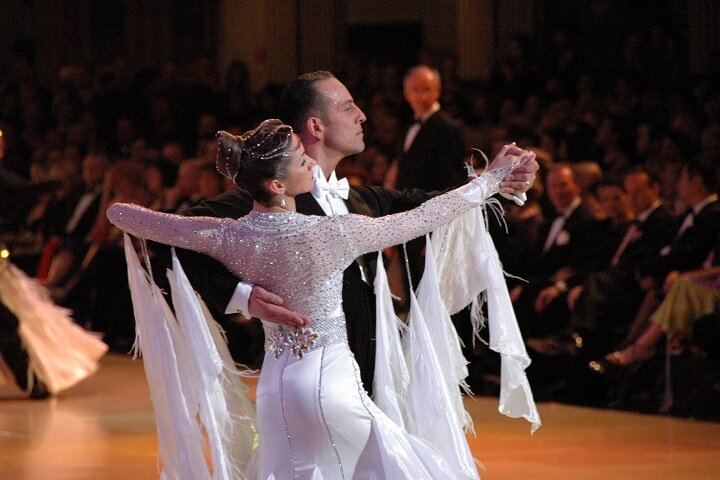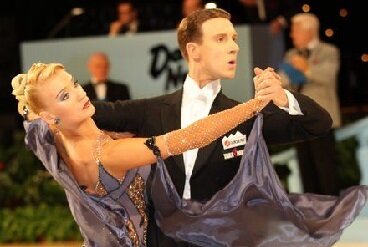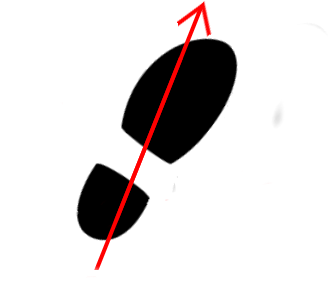Promenade Position 
22 June 2016
Let's face it, Promenade Position is tough. Even in the higher syllabus levels, a good Promenade Position separates the finalists from the semifinalists. This article will shed a little insight into that accursed position, and even provide an exercise that might make it a bit easier for you during your dancing.
The Position
For the Man
Stand in Closed Position. Try to keep your shoulders parallel to the Lady, but turn the hips to the left so that you can walk in that direction. Now check your shoulders again, and make sure they are mostly parallel with the Lady still. The most common fault is that the right shoulder will go into the Lady's space, and the right elbow will go back behind the body. Also, remember that both elbows must remain up, even in Promenade Position.
For the Lady
Stand in Closed Position. Try to keep your shoulders parallel to the Man, but roll your hips clockwise around and behind the Man's hips. Now check your shoulders again, and make sure they are mostly parallel with the Man still. The most common faults are that the shoulders do not stay parallel with the Man's, or that the hips do not end up behind the Man's. Also, remember that both elbows must remain up, even in Promenade Position.
How much should the hips turn?
Most dancers end up turning their hips approximately 1/8. Different dancers visualise different things to get there. Danny Quilliam, North American Champion, recommends not feeling like the hips turn at all, since they will naturally turn to allow you to step through. Anna Mikhed, World Finalist, recommends trying to turn the hips as much as possible, restricted by keeping your shoulders parallel.
Do I need to stay totally parallel in the shoulders?
No, but you should feel that you do. Look at this picture of Arunas and Katusha, current World Champions, in Promenade Position in Tango.

They are not totally parallel, and that is okay. However, it is extremely easy and comfortable to open out in the shoulders too much, so you should always feel that you are parallel. Sometimes, you may feel that you are parallel and even that isn't enough, and you have opened out too much. For small details like this, it is best to get your coach to critique you.
Achieving the Position
Typically in dancing, we don't just swivel to Promenade Position while in place, but dance into it with a figure. Depending on whether the figure turns to the right or the left, the entry to Promenade Position will be different.
Turning to the Right
Examples: Whisk, Open Impetus, Turning Locks to Right, Progressive Link, Natural Twist Turn
N.B. Even though in the Whisk and the Progressive Link, the couple doesn't rotate to the right, in both the Man's foot alignment doesn't change, while the Lady's turns to the right.
When turning to the right to Promenade Position, at the point of opening to Promenade Position, the Man's feet, knees, and hips will not turn, but his shoulders will turn to the right to stay with the Lady. Contrariwise, the Lady will feel that she doesn't turn her shoulders at all, but that her feet, knees, and hips turn to the right. Take the Open Impetus, for example. Between steps 2 and 3, the Man will stop turning his feet, but continue to turn his shoulders until he reaches Promenade Position. The Lady at that time will stop turning her shoulders so as to keep them with the Man, but continue to turn her feet until she reaches Promenade position.
Turning to the Left
Examples: Open Telemark, Outside Change ended in PP, Weave ended in PP, Tango Reverse Turn Outside Swivel
Turning to the left is the exact opposite of turning to the right. When turning to the left to Promenade Position, at the point of opening to Promenade Position, the Man's feet, knees, and hips will turn to the left, but his shoulders will not turn away from the Lady. The Lady will feel that her feet, knees, and hips do not turn, while her shoulders turn to the left to achieve Promenade Position. Take the Open Telemark for example. Between steps 2 and 3, the Man will stop turning his shoulder, but continue to turn his hips to the left until his reaches Promenade Position. The Lady will stop turning her hips, since they are already at the correct alignment, but continue to turn her shoulders to Promenade Position.
Moving in Promenade Position
Walking in Promenade Position is tricky, because it requires that you step across yourself. Practice this: As a Man, stand with your feet facing DW and your shoulders turned toward Wall, or as a Lady, stand with your feet facing DC and your shoulders turned toward Centre. Now walk down LOD, keeping your feet at their alignments.
Feel that as you step with your outside foot, you land on the inside edge of the heel, and then come to the centre of the foot. From there, as you step through and off the foot, you continue to roll through the foot diagonally, and end on the outside edge of the toe. Now as you step with your inside foot, feel that you land on the outside edge of the heel, and then come to the centre of the foot. From there, as you step through and off the foot, you continue roll through it diagonally, and end on the inside edge of the toe. This is the feeling of walking in Promenade Position.

As you do this, check your positioning. Make sure your shoulders remain turned to your imaginary partner. Practicing this for a few minutes alone, and then practice it in Promenade Position with your partner. You will feel a huge difference in your dancing.